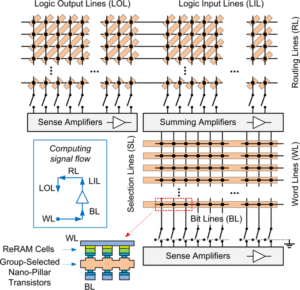TNANO Article in focus: May-June 2017
Article in Focus from the May 2017 issue of IEEE Transactions on Nanotechnology
Crossbar-Based Memristive Logic-in-Memory Architecture
by Georgios Papandroulidakis ; Ioannis Vourkas ; Angel Abusleme ; Georgios Ch. Sirakoulis ; Antonio Rubio
T-NANO, Vol. 16, Issue 3, pp. 491 – 501, May 2017.

Abstract: The use of memristors and resistive random access memory (ReRAM) technology to perform logic computations, has drawn considerable attention from researchers in recent years. However, the topological aspects of the underlying ReRAM architecture and its organization have received less attention, as the focus has mainly been on device-specific properties for functionally complete logic gates through conditional switching in ReRAM circuits. A careful investigation and optimization of the target geometry is thus highly desirable for the implementation of logic-in-memory architectures. In this paper, we propose a crossbar-based in-memory parallel processing system in which, through the heterogeneity of the resistive cross-point devices, we achieve local information processing in a state-of-the-art ReRAM crossbar architecture with vertical group-accessed transistors as cross-point selector devices. We primarily focus on the array organization, information storage, and processing flow, while proposing a novel geometry for the cross-point selection lines to mitigate current sneak-paths during an arbitrary number of possible parallel logic computations. We prove the proper functioning and potential capabilities of the proposed architecture through SPICE-level circuit simulations of half-adder and sum-of-products logic functions. We compare certain features of the proposed logic-in-memory approach with another work of the literature, and present an analysis of circuit resources, integration density, and logic computation parallelism.

